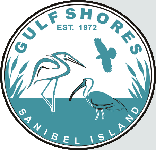Our Native Flora
MEET THE NATIVES
Compiled by Cynthia Rice and Lillian Decker
We have a number of Florida native plants in Gulf
Pines (Ed. note: and Gulf Shores too). Have you seen them all? The following descriptions are taken from Native
Florida Plants by Robert Haehle and Joan Brookwell
COMMENTS ARE WELCOME, PARTICULARLY IF YOU KNOW OF A SPECIMEN
OR ATTRIBUTE OF A SPECIMEN THATS MISSING.
PALMS
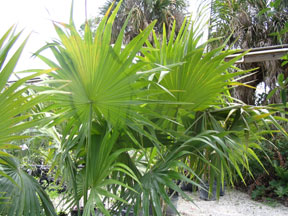 |
Florida Thatch Palm Thrinax radiata
Size: 20-25
Bloom: tiny white flowers in 3-5 clusters
Fruit: clusters of ½ white berries
Foliage: 3 wide, fan shaped leaves, green above and yellow-green below
Bark: rough, gray-brown
Native range: Southern Florida and the West Indies
Habitat: Open woodsy areas and shores
Notes: salt tolerant and pest-free, a very desirable small palm, attractive to the Monk Skipper butterfly, too.
Location: Snowberry Lane
|
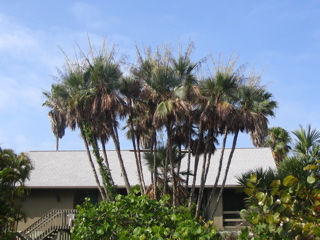 |
Paurotis Palm, Everglades Palm Acoelorrhaphe wrightii
Height 20
Bloom: small white flowers in 3 clusters in summer
Fruit: Shiny black, ½ berries
Foliage: 3 fans
with spiny stems, green on top, silvery below
Bark: Slender stems are rough textured, warm brown with the
remains of old leaves clinging to them.
Native range: South and Central Florida and the Caribbean
Habitat: Swampy areas
Notes: A slow
growing, but beautiful palm, it might get to 30 feet if happy. If left unpruned, the tree, forms a good
dense screen
Location: Small pool and elsewhere
|
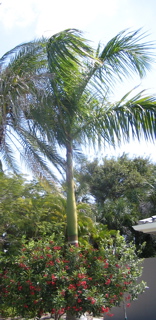 |
Royal Palm Roystonea
elata
Size: 100
Bloom: Tiny white flowers in 2 clusters
Fruit: ½ purple-black berries
Foliage: 15 fronds 6 feet across can weigh 60-70 lbs.
Bark: Smooth cement like trunk topped by a smooth, pale
green 8 crownshaft
Native range: Everglades
Habitat: Open, moist elevated sites
Notes: A spectacular tree, nectar plant for
butterflies. Plant it where its heavy
fronds wont do damage when they fall.
Location: Throughout
|
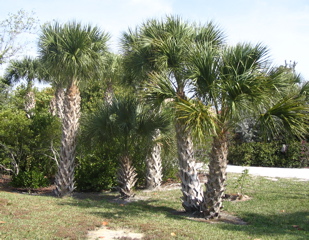 |
Sabal Palm, Cabbage Palm
Sabal palmetto
Size: 50-60
Bloom: Fragrant, small white flowers in clusters on 3 stems
in early summer
Fruit: Edible, ½ berries in fall
Foliage: Large fan-shaped leaves are 3-5 across
Bark: Smooth gray-brown or criss-crossed with the boots lf
last years leaves
Native range: West Indies, Bahamas, Virginia through Florida
Habitat: Anywhere but standing water or dense shade
Notes: the state tree of Florida. Butterflies love its flowers and many birds
and other wildlife, its berries.
Location: Throughout |
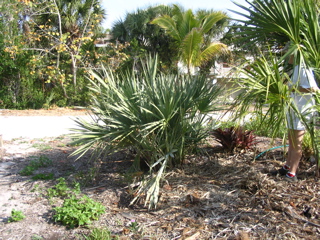 |
Saw Palmetto Serenoa repens
Size: 6-12
Bloom: Long branches of tiny white blossoms
Fruit: Ύ black
berries
Foliage: Green or silvery-green fans with spiny stems
Bark: Creeping brown stems for dense thickets.
Native range: Carolinas through Florida
Habitat: Dunes and sandy pinewoods
Notes: Folklore considered this sprawling palm a habitat for
varmints and native Americans ate its fruit.
Now its valued in the landscape as a mass planting, a woodsy
groundcover or barrier and favorite of the Monk Skipper butterfly. Honey from its flowers is very tasty
Location: Throughout
|
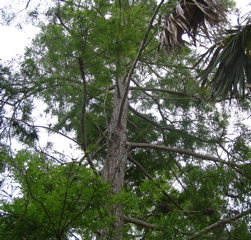 |
LARGE TREES
Bald Cypress Taxodium distichum
Size: 70
Bloom: Small greenish male flowers in 4-5 panicles;
females, globular green cones
Fruit: 1 brown cones
Foliage: ½ needles fall in winter. Fresh, pale green
foliage appears in February
Bark: Fibrous,
reddish brown
Native range:
Southeastern U. S.
Habitat: Wetlands, but adaptable to drier sites
Notes: A signature tree of the Deep South, along with the
live oak and magnolia, its very wind resistant
Location: Gulf Pines Drive, by Messick House
|
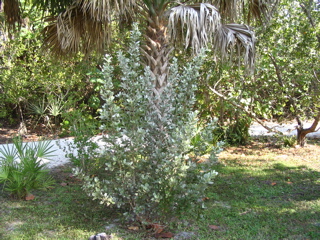 |
Buttonwood Conocarpus erecta
Size: 40-50, Silver one is 20-35
Bloom: Tiny greenish white flowers all year
Fruit: Round, woody ½ cones
Foliage: Oval, pointed leaves, 3-4 ling are dark green or
silvery
Bark: Rough, gnarled and channeled
Native range: South Florida and Caribbean
Habitat: Brackish swamps and high ground
Notes: A popular ornamental tree with an open, spreading
canopy. They withstand wind, salt and
drought, and their rough bark is ideal for growing orchids and bromeliads
Location: Throughout
|
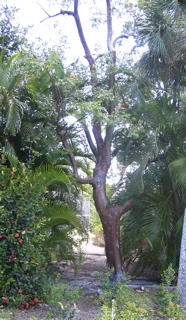 |
Gumbo Limbo Bursera simaruba
Size: 50-60
Bloom: Tiny greenish flowers in spring
Fruit: Dark, brick red ½ fruits with white seeds
Foliage: glossy green leaves 1-3 long
Bark: bronzy colored skin peels to reveal a smooth
brown-green skin
Native range: South Florida, West Indies, Mexico
Habitat: Open hammocks and woodlands
Notes: Called the tourist tree because of its peeling
bronze colored skin, it is fast growing and easy to start by plunging a branch
directly into the soil. Flycatchers
love it.
Location: Throughout
|
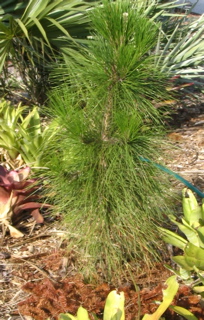 |
Longleaf Pine Pinus palustris
Size: 60-80
Bloom: Purple flowers in spring
Fruit: Large, 6-10 brown cones
Foliage: Glossy, 9-18 drooping needles in bundles of 3
Bark: Thick, brown, fire resistant
Native range: Southeastern U.S.
Habitat: Dry sandy sites
Notes: A majestic, landscape tree, it prefers acid soil
(coffee grounds). Its needles are used
in basket making
Location: Snowberry Lane
|
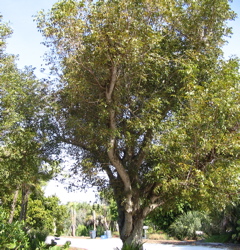 |
Live Oak Quercus
virginiana
Size: 50-60
Bloom: Pendulous 3 yellow catkins
Fruit: Ύ acorn
Foliage: Leathery
oval 3-4 leaves are dark green on top paler beneath
Bark: Channeled, dark brown
Native range: Southeastern U. S.
Habitat: Dominant tree of open woodlands
Notes: A distinctive southern tree often draped in Spanish
moss, it can spread 150. Birds love the acorns: skipper & hairstreak
butterflies, its flowers.
Location: Small pool and elsewhere
|
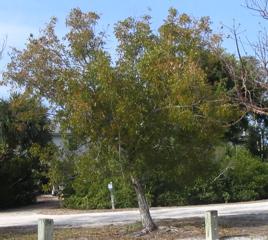 |
Mahogany Sweitenia
mahogani
Size: 60-70
Bloom: Tiny yellow flowers in spring
Fruit: A 5 oval brown pod in fall
Foliage: Compound leaves with 3-4 dark green leaflets
Bark: Rough, dark
grayish brown
Native range: South Florida & Caribbean
Habitat: Open
woodlands
Notes: A fine spreading shade tree, adaptable to many
conditions except wet.
Location: Large pool & elsewhere
|
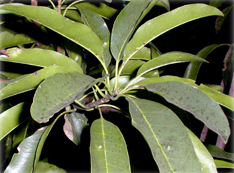 |
Mastic Mastichodendron
foetidissimum
Size: 50-60
Bloom: Tiny yellow flowers
Fruit: 1 oval yellow berries in spring
Foliage: Oblong, dark green leaves, 7-8 long with wavy
edges flutter in the sltghtest breeze
Bark: Rough, dark brown
Native range: South Florida & Caribbean
Habitat: A major canopy tree in hardwood hammocks
Notes: An attractive, pest-free evergreen in the landscape,
its salt tolerant, very resistant to strong winds, and adaptable to many soil
conditions. Its edible fruit is
attractive to wildlife, too.
Location: Beach path
|
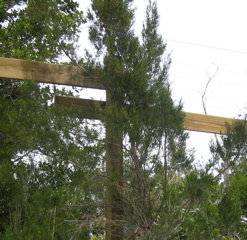 |
Red Cedar, Southern Red Cedar Juniperus
virginiana
Size: 45
Bloom: Male and female flowers are on separate trees in
spring. Green and cone-like or
yellow-green
Fruit: Tiny round powdery blue berries are used to make gin
or flavor sauerkraut
Foliage: Bluish to yellowish, fragrant scaly needles
Bark: Exfoliating reddish to gray
Native range: East of the Rockies
Habitat: A pioneer plant in old fields, it needs sun and
good drainage
Notes: A very versatile tree, salt tolerant and useful as a
specimen, screen or windbreak, providing food and shelter for many birds.
Location: Little pool
|
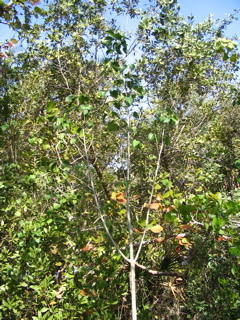 |
Shortleaf Fig Ficus citrifolia
Size: 40-50
Bloom: Rounded cups with flowers inside
Fruit: Ό - ½ figs turn red when ripe
Foliage: Oval leaves with a blunt point, 2-4 long
Bark: Smooth light to yellowish brown
Native range: South Florida and Bahamas & West Indies
Habitat: Tropical hammocks
Notes: Better behaved than the strangler fig, but like all
figs, has aggressive roots. Its fast
growing with an attractive, spreading canopy and tolerates poor soil and
salt. Birds and butterflies find it
attractive, too
Location: Beach path near Haffenreffers
|
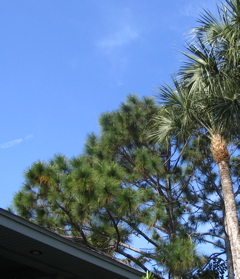 |
Slash Pine Pinus elliotii
Size: 70-80
Bloom: Tiny brown flowers in spring
Fruit: 3-5 cones
Foliage: Shiny dark green needles, 8-12 long in bundles of
2-3
Bark: Rough dark brown plates
Native range: Southeastern U.S.
Habitat: Open woodlands and fields
Notes: Drought tolerant and adaptable to many soils, but is
sensitive to disturbance and irrigation. The fruit is enjoyed by many birds and
small animals
Location: Clubhouse
|
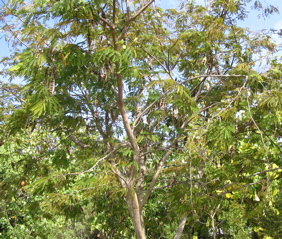 |
Wild Tamarind Lysiloma latislilqua
Size: 50-60
Bloom: Fragrant white ½ powder puffs
Fruit: Brown & beige pods, 5 long
Foliage: Compound leaves with delicate 1/3 leaflets
Bark: Light gray to brown
Native range: South Florida & Caribbean
Habitat: Woodland
Notes: A large fast growing tree with an airy canopy. It tends to drop branches, the roots are
shallow and the leaves will stain what they fall upon. Its best to plant in groundcover. Large Orange Sulfur and Cassius Blue
butterflies, love it.
Location: Beach path
|
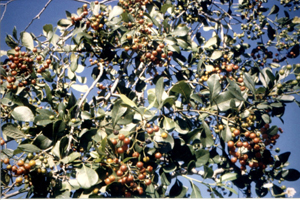 |
SMALLER TREES
Bahama Strongbark Boureria ovata
Size: 20
Bloom: Fragrant, ½ white flower clusters most of the year
Fruit: Showy clusters of ½ red-orange berries
Foliage: Glossy yellowish-green oval leaves, 2-4 long,
evergreen
Bark: Reddish brown, scaly
Native range: South Florida, Bahamas, West Indies
Habitat: Hardwood hammocks, Pinelands
Notes: A decorative, small tree, adaptable to many soils,
and drought tolerant. Attractive to hummingbirds and butterflies.
Location: Snowberry Lane
|
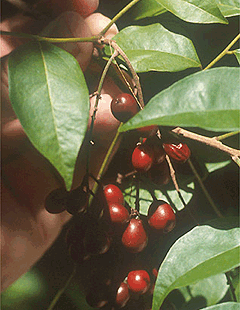 |
Bitterbush Picramnia pentandra
Size: 10-15
Bloom: Inconspicuous clusters in summer, males and females
separate
Fruit: Red, ½ berries turn black when ripe
Foliage: Alternate, compound leave with 2-4 dark green
leaflets
Bark: Smooth yellow-brown
Native range: South Florida, Caribbean
Habitat: Sandy, well drained soil
Notes: A good choice for small spaces; blossoms make good
honey
Location: Gulf Pines Island near Erikssons
|
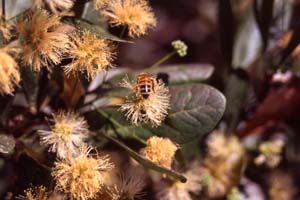 |
Blackbead Pithecellobium guadalupense
Size: 20
Bloom: Fuzzy rounded 1 flowers are either pink or white
Fruit: Reddish brown, 2-4 pods expose glossy black seeds
Foliage: Compound with 1-3 rounded leaflets, pinkish new
growth
Bark: Rough, brown
Native range: South Florida, Caribbean
Habitat: Hammocks, dunes, fields with sandy dry soil
Notes: Useful where little else will grow, its an
attractive, small no maintenance, evergreen.
It attracts butterflies
Location: Snowberry Lane
|
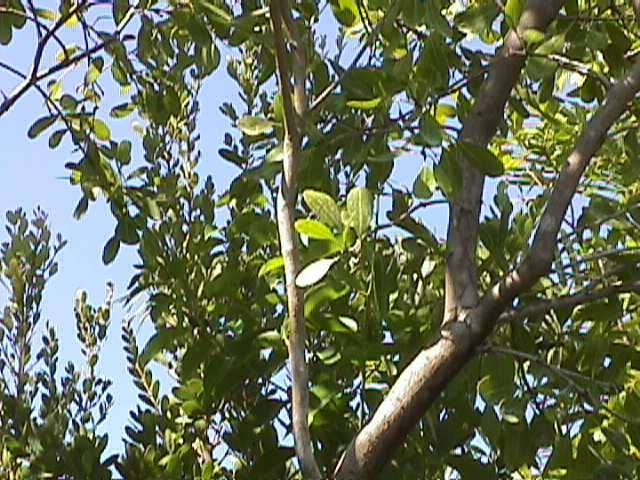 |
Blolly, Longleaf Blolly Guapira
discolor, G. longifolia
Size: 30
Bloom: Inconspicuous yellow/green in spring
Fruit: Decorative red ½ berries
Foliage: Oblong opposite, pale green leaves, 1-2 long, half
as wide
Bark: Pale reddish brown
Native range: South Florida, Caribbean
Habitat: Hardwood hammocks
Notes: An attractive small tree with rounded canopy, Birds
like the decorative fruits
Location: Beach path
|
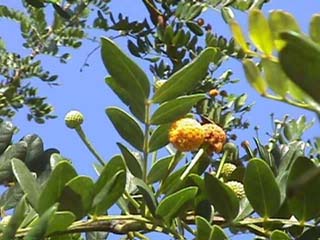 |
Cinnecord Acacia choriophylla
Size: 15-20
Bloom: Bright yellow, ½ powder puffs
Fruit: Flat 2 green, then brown pods
Foliage: Compound leaves, 1-3 times divided, with dark green
Ύ leaflets
Bark: Smooth, dark brown
Native range: South Florida, Bahamas, West Indies
Habitat: Dry, sunny areas
Notes: Very attractive, often multi-stemmed small tree,
low-maintenance and beloved of butterflies.
Location: Corner of Snowberry & Gulf Pines, next to the
wild lime
|
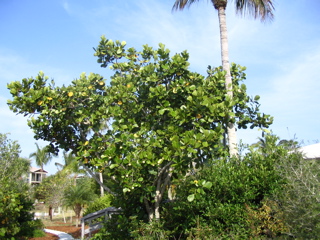 |
Clusia, Autograph Tree, Pitch Apple Clusia
rosea
Size: 30
Bloom: Showy, drooping 3 flowers with pink and white petals
in summer
Fruit: 3 green pod
Foliage: Oval, thick and leathery with a prominent midvein,
3 long
Bark: Smooth gray-brown
Native range: Florida Keys, Bahamas
Habitat: Keys
Notes: A dense tree, but very salt & wind tolerant. Beware its aggressive roots and remove the
seedlings from canopies of palms
Location: Clubhouse
|
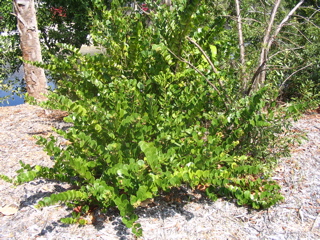 |
Cocoplum Chrysobalanus
icaco
Size: 15-20
Bloom: Tiny fragrant white flowers all year
Fruit: Edible, round purple fruits 1½ or larger
Foliage: Shiny, rounded, leathery leaves are 3 long
Bark: Brown
Native range: South Florida, Caribbean
Habitat: Tropical hammock, woodlands
Notes: An attractive, small tree, it makes a good hedge or
screen. The red-tip variety is not as
salt tolerant as the green
Location: Throughout
|
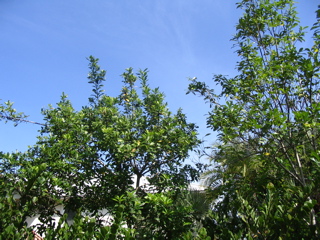 |
Dahoon Holly Ilex cassine
Size: 35
Bloom: Small white flower clusters in spring
Fruit: Bright red berries in fall & winter on female
trees
Foliage: Oblong, 3-5 glossy leaves thih tiny tooths at the
margins
Bark: Smooth, pale gray
Native range: Virginia to Florida & the Bahamas
Habitat: Near Streams or swamps, but tolerates drier sites
Notes: Berries are poisonous, but the birds eat them without
harm
Location: Beach path, Snowberry Lane
|
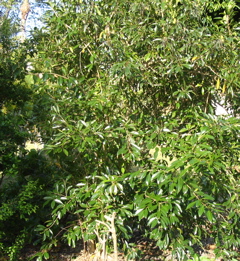 |
Fiddlewood Citharexylum fruticosum
Size: 15-20
Bloom: Very fragrant white flowers in 2-4 panicles
Fruit: Females produce clusters of Ό reddish to black
berries
Foliage: Very glossy pointed oval leaves, 4-5 long. Leaves are smooth and leathery, stalks
orange/pink.
Bark: Smooth, light brown and fissured in older trees
Native range: South Florida, Caribbean
Habitat: Open woodlands
Notes: Leaves sparkle in the sun, butterflies flock to its
flowers, birds love the berries, fragrance perfumes the air. Whats more to say?
Location: Beach path and elsewhere
|
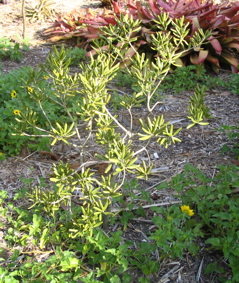 |
Joewood Jacquinia
keyensis
Size: 15 with time
Bloom: Fragrant, ½ star-shaped flowers all year
Fruit: Red to yellow ½ fruits in drooping clusters
Foliage: Thick, narrow pale green ovals 2-4 long ½ wide
Bark: Pale gray, smooth
Native range: South Florida, Bahamas
Habitat: Edges of tropical hammocks, seashore
Notes: A very choice evergreen, tolerant of sun, salt,
drought. All parts of it are poisonous.
Location: Snowberry Lane
|
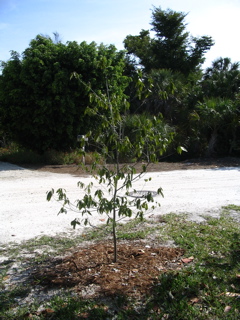 |
Lancewood Nectandra
coriacea
Size: 30-35
Bloom: White ½ flowers in spring
Fruit: Blue-black ½ berries in orange bases
Foliage: Smooth, fragrant evergreen leaves droopm from the
branches
Bark: Reddish brown, sometimes corky
Native range: South Florida, West Indies
Habitat: Tropical woodlands
Notes: An attractive, small shade tree; its flowers make
good honey
Location: Small pool
|
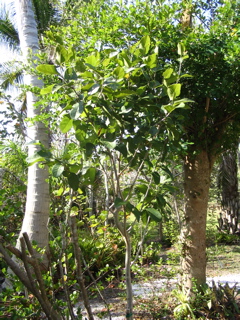 |
Pigeon Plum Cocoloba diversifolia
Size: 30-40
Bloom: Spikes of small white flowers in early spring
Fruit: Narrow clusters of edible, ½ berries
Foliage: Thick, oval 34 leaves vary in size and shape
Bark: Light gray,
and peeling on older trees
Native range: South Florida, Caribbean
Habitat: Woodlands
Notes: A narrow, upright tree, useful in many situations
Location: Beach path
|
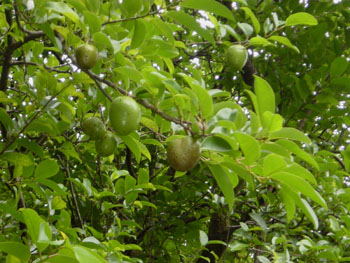 |
Pond Apple Annona glabra
Size: 30-35
Bloom: 1 pale yellow flowers
Fruit: 5 rounded, edible yellow fruit
Foliage: Alternate, leathery ovals, about 7 long
Bark: Shiny reddish twigs get rougher as they grow larger
Native range: South Florida, Caribbean
Habitat: Swamp areas, but adaptable to drier sites
Notes: In nature this tree is often draped with orchids,
ferns or bromeliads, so its a good one for displaying treasures
Location: Gulf Pines Drive, near Erickssons
|
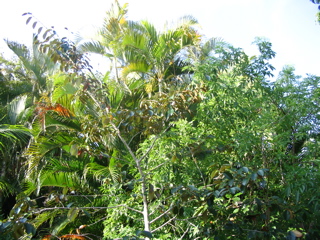 |
Satinleaf Chrysophyllum
oliviforme
Size: 25-30
Bloom: Small yellowish white flowers in the fall
Fruit: Edible, oblong 1 fruit ripens in spring
Foliage: Oval, pointed, 5-6 long, glossy green above and
downy, copper colored beneath
Bark: Dark brown
Native range: South Florida, Caribbean
Habitat: Hardwood hammocks in sun/light shade
Notes: One of our most beautiful native trees; the birds
love its fruit
Location: Cabbage Palm Court, Snowberry Lane
|
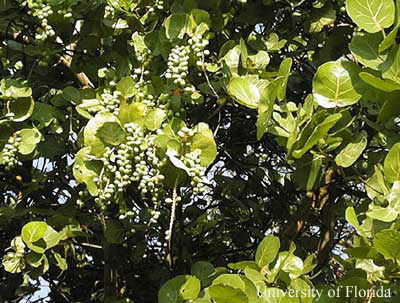 |
Seagrape Cocoloba
uvifera
Size: 30
Bloom: Tiny white flowers in 10 spikes
Fruit: Edible purple berries in long clusters; good for
jelly
Foliage: Large, round leaves, green with red veins, then
turning red. New growth is stunning, glossy bronze
Bark: Smooth, peeling, gray-brown
Native range: South Florida, Caribbean
Habitat: Coastal dunes, hammocks
Notes: Extremely salt and wind tolerant with a massive,
spreading canopy. In the wild, its
fallen leaves make a beautiful carpet and the birds enjoy its fruit
Location: Throughout
|
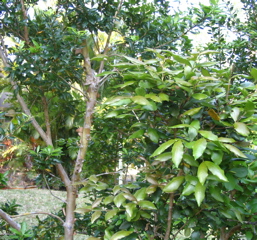 |
Simpson Stopper Myrcanthes
fragrans
Size: 20
Bloom: Fuzzy white Ό flowers in summer
Fruit: Red-orange berries
Foliage: Opposite, deep green fragrant ovals, ½-1 long
Bark: Tan, exfoliating
Native range: South Florida, West Indies
Habitat: Tropical hammocks
Notes: One of our most attractive small trees with fragrant
flowers and leaves, decorative fruit and bark, a dense shrub, good for
screening and it attracts the birds
Location: Small pool
|
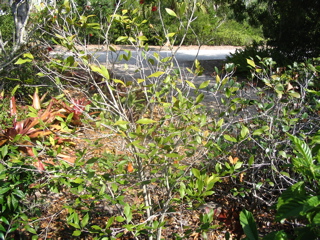 |
Spicewood, Pale Lid Flower Calyphranthes
pallens
Size: 20
Bloom: Fragrant, pale greenish white clusters in late spring
Fruit: Ό berries change from green to orange to black
Foliage: 3 oval, pointed leaves, glossy above and slightly
fuzzy below, they emerge bronzy pink then turn green.They have a spicy fragrance
Bark: Pale gray-brown
Native range: South Florida, Caribbean, West Indies, Mexico
Habitat: Edges of hammocks, understory, fields. It likes the
damp
Notes: They make good hedges, or small shade trees. Fruit, fragrant & colorful foliage &
flower provide interest all year. Birds like the food and shelter
Location: Snowberry & Gulf Pines, Rice dooryard
|
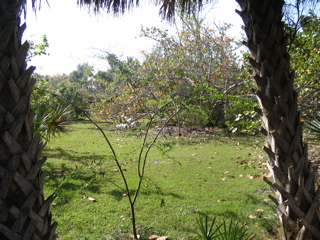 |
Sweet Acacia Acacia farnesiana
Size: 15
Bloom: Very fragrant, bright yellow Ύ powder puffs all year
Fruit: Cylindrical 2-3 brown pods, often in clusters
Foliage: Twice compound, ferny leaves with tiny bright green
leaflets
Bark: Shaggy, reddish brown with narrow ridges; very thorny
Native range: South Florida, Mexico, Central America
Habitat: Sunny, dry sandy areas
Notes: An attractive tree with a light, airy
appearance. The thorny branches provide
good nesting sites for the birds and its flowers are used to make perfume.
Location: Snowberry Lane, beach path
|
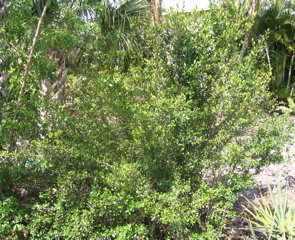 |
Walter Viburnum Viburnum
obovatum
Size: 20
Bloom: Clusters of white flowers in early spring
Fruit: Red to black 1/8 berries
Foliage: 1 oval evergreen leaves are glossy, dark green
above, paler & spotted beneath
Bark: Rough, reddish brown
Native range: Eastern U. S.
Habitat: Swamps and hammocks near the coast
Notes: With showy flowers and berries for the birds, it
makes a good small shade tree, hedge or screen
Location: Corner of Black Skimmer & Gulf Pines
|
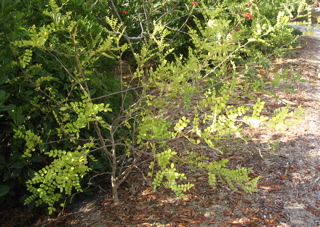 |
Wild Lime Zanthoxylum fagara
Size: 25
Bloom: Insignificant green clusters all year
Fruit: Round, brown, 1/8 in summer/fall
Foliage: Shiny compound leaves with 1 leaflets and, a
distinctive, winged stem
Bark: Rough dark gray-brown
Native range: South Florida, Caribbean, Bahamas
Habitat: Edge of woods
Notes: A small tree with attractive, lacy foliage; its
thorny stems make a useful barrier
Location: Beach path & elsewhere
|
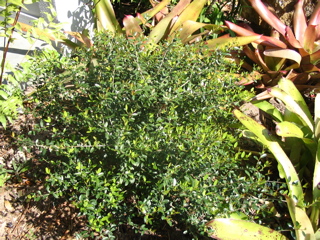 |
Yaupon Holly Ilex vomitoria
Size: 20-25
Bloom: Tiny white flowers in spring & summer
Fruit: Red-orange berries on female trees
Foliage: Small, glossy 12 ovals
Bark: Smooth pale gray
Native range: Coastal New Jersey to Florida & Texas
Habitat: Wet or dry, woodlands
Notes: Very
adaptable, tolerant of cold, salt & shade.
It can be pruned as a hedge and dwarf forms are for foundation planting
Location: |
|
